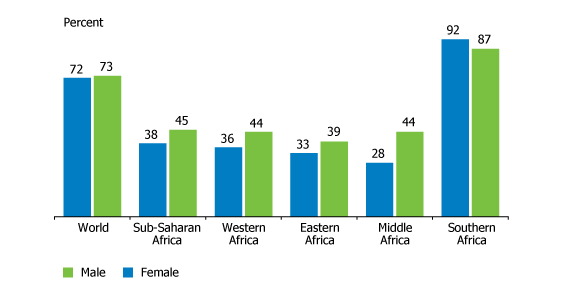Kristen Devlin
Former Program Associate

April 1, 2013
Former Program Associate
The youth population in sub-Saharan Africa is increasing rapidly. Nearly one in three people living in the region, or about 297 million, is between the ages of 10 and 24. By 2050, that age group is projected to nearly double to about 561 million, according to PRB’s The World’s Youth 2013 Data Sheet.1
The youth of the region are also becoming better educated. Estimates show that the proportion of 20-to-24-year-olds who complete secondary education will increase from 42 percent to 59 percent over the next 20 years.2 Consequently, as sub-Saharan Africa’s workforce becomes larger and better educated, there is an overwhelming potential for economic growth and development. Countries must take the opportunity to cultivate the capacity of their youth, a valuable resource for their prosperity.
Youth unemployment remains a barrier to the region’s development. Some of the highest rates on the continent are in southern Africa, where 51 percent of young women and 43 percent of young men are unemployed. This large unemployed population indicates lost potential since communities and nations fail to benefit from what the young people could theoretically contribute. Also, difficulties finding and sustaining employment detract from a young person’s lifetime productivity and earnings, making it more challenging to escape poverty.
One of the reasons young people are having trouble finding employment is a limited number of jobs. Between 2000 and 2008, only about a third of the 74 million jobs created in Africa were for people ages 15 to 24.3 This challenge causes young people to settle for less-than-ideal employment, such as jobs that are low-paying, temporary, or unsafe, or ones for which they are overqualified. Some enter the informal economy to make ends meet. Others stop looking for jobs altogether. These groups are difficult to measure and are not included in typical unemployment figures.
But the number of available jobs for young people is only part of the problem. While improving, educational systems are still failing to provide a large proportion of youth with the skills they need to secure a living. Without the ability to attain basic skills or the specific ones that match the demands of the labor market, many youth are unable to find employment.
Certain types of skills determine whether young people will be able to find work, contribute to their local and national economies, and live up to their individual developmental and earning potentials:
In many sub-Saharan African countries, at least half of young people ages 15 to 19 lack foundation skills, often because they had never attended school or they dropped out of school before gaining basic literacy or numeracy.5 In eastern Africa, 37 percent of girls and 32 percent of boys of lower secondary-school age are not attending school. In some countries, however, the situation is much more dire: In Niger, 83 percent of girls and 74 percent of boys are not in school.6 Some leave school to work in low-skill jobs where the possibility of advancement is limited, and national education systems provide little opportunity to gain these critical skills in the future.
Opportunities to develop a specific set of skills that matches the needs of the job market are often limited. Even if young people finish primary school, they do not necessarily progress to secondary school or have the skills needed by employers.
Secondary School Enrollment in Sub-Saharan Africa, 2005/2011

Source: Donna Clifton and Alexandra Hervish, The World’s Youth 2013 Data Sheet (Washington, DC: PRB, 2013).
Recent reports from UNESCO and the International Labour Organization have recommended that governments, the private sector, and international donors pursue integrated, comprehensive policies and strategies that create jobs for young people and improve the transition between school and work.7
Some strategies include policies to improve labor standards and social protection for youth, like acceptable wages and work conditions; and programs that target specific youth populations, like disadvantaged young women, to boost their skills and employability. Second-chance education for individuals with low or no foundation skills will help these youth catch up later in life. Decisionmakers need to listen to the voices of young people and allow opportunities for dialogue. Recommendations also include improving the ability to measure the mismatch between what youth know and what employers need.
Today, economies in sub-Saharan Africa are experiencing rapid growth, averaging 5.3 percent in GDP growth in 2012—well above the world average of 3.3 percent per year. At the same time, approximately 2 million people will enter the labor market from now until 2015.8 With a greater appreciation of the size and economic potential of young people and more comprehensive education-to-employment strategies, sub-Saharan Africa will be able to make the most of this opportunity for development.
